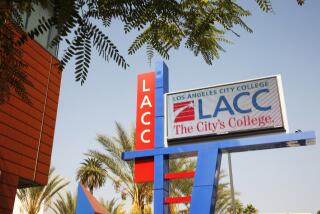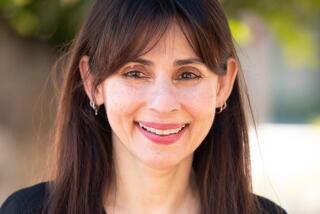Mission College Gathers Public Input on Expansion
- Share via
SYLMAR — Making good on an earlier promise to involve community groups in campus expansion plans, Mission College officials welcomed area residents and activists to a brainstorming session Friday aimed at crafting a five-year development plan for the community college.
The session was held in part to make amends for last year’s forfeiture of $4.7 million in state funds earmarked for a new classroom building, additional parking and athletic fields needed to meet the school’s growing 6,000-student population, which is projected to double by 2003.
President William E. Norlund, who announced he will retire in June, acknowledged at a community forum in November that college officials waited too late to solicit opinions from community groups regarding the expansion plans.
As a result, administrators were unable to meet a state-imposed deadline to use the money by Dec. 30, 1998. Assemblyman Tony Cardenas (D-Sylmar) has since introduced an emergency bill to return the money to Mission, but he said its passage is uncertain.
“We are starting over at ground zero,” Shari Borchetta, vice president of administration, said Friday. “Previously, we were not able to come up with a proposal. We had to regroup.”
At Friday’s session, about 35 community activists, legislative aides and campus leaders sat at tables set up in a semicircle as moderator Patrick McCallum, strategic planner and legislative advocate for the Los Angeles Community College District, acted as a sounding board for their vision of how the college will look five years from now.
The wide-ranging ideas included building a cultural center, student center, child development center, parking garage and athletic fields as well as purchasing land where they will be built.
*
Beyond the capital development wish list, the group also assessed the college’s strengths and weaknesses as well as the opportunities and barriers it faces in bringing about change.
Participants cited the college’s diverse faculty and student body, modern buildings, safe location and smaller class sizes as its strengths.
Limited funding, high dropout rates, high turnover in senior staff positions, inadequate student health-care facilities and insufficient parking were mentioned as weaknesses.
The group agreed that the college needs to create more educational opportunities for students by reaching out to private foundations, corporations, government, community organizations and other colleges and universities to establish mutually beneficial partnerships.
They also acknowledged that the college must overcome some barriers, particularly in developing a stronger relationship between the school and the community it serves. To do this, they said, school officials must be more aggressive in getting the word out through the news media, neighborhood meetings, open houses, advertisements and the campus’ Internet Web site about the positive things happening on campus.
*
Borchetta said the ideas raised at the meeting will be combined with those suggested by faculty and staff at an earlier session. A summary will later be shared at three off-campus community meetings, beginning in February.
“We hope we can come up with practical goals and commitments to carry them out,” she said. “We need a strategic plan that meets the needs of the students and faculty in the next five years.”
More to Read
Sign up for Essential California
The most important California stories and recommendations in your inbox every morning.
You may occasionally receive promotional content from the Los Angeles Times.













